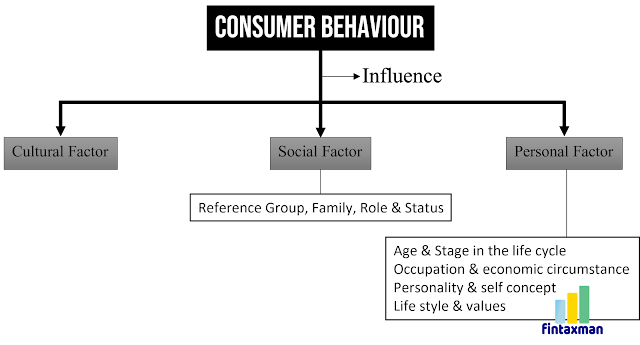Define Consumer Behaviour?
Consumer behaviour is the study of individual, groups, or organizations and all the activities associated with the purchase, use and disposal of goods and services. Consumer behaviour consists of how the consumer’s emotions, attitudes, and preference affect buying behaviour. Consumer behaviour observes how people choose, use and discard products and services encompassing their emotional, cognitive and Behavioural reactions.
Consumer behavior can be defined as the decision-making process and physical activity involved in acquiring, evaluating, using and disposing of goods and services. It is the study of when, why, how, and where people do or do not buy a product. It blends elements from psychology, sociology, social anthropology and economics. It is based on consumer buying behavior, with the customer playing the three distinct roles of user, payer and buyer. It is difficult to predict, even for experts in the field.
- Psychology - Some consumers believe that products that are costly are more effective like they prefer Dove in comparison to Santoor.
- Sociology - Still in many villages people resist using any other brand other than Lifebuoy.
- Economics - some people experiment with their brands according to their economic capability. A process of buying starts in the minds of the consumer, which leads to the finding of alternatives between products that can be acquired with their relative advantages and disadvantages. This leads to internal and external research.
Definition of Consumer Behaviour
- According to Engel, Blackwell, and Mansard - Consumer behaviour is the actions and decision processes of people who purchase goods and services for personal consumption.
- According to Louden and Bitta - Consumer behaviour is the decision process and physical activity, which individuals engage in when evaluating, acquiring, using or disposing of goods and services.
What Influences Consumer Behaviour?
Cultural Factors
- North & south India Fooding habits like north Indian people’s favour tea over coffee, like that South Indian people’s favour coffee instead of tea.
- A child growing up in the United States is exposed to the different values than a child growing up in a traditional middle-class family in India. Indian child is exposed to the following values respect and care for elders, honesty and integrity, hard work, achievement and success and sacrifice.
- Social classes show distinct product and brand preferences in many areas including clothing, home furnishing, leisure activities, and automobiles.
- Social classes differ in media preferences with upper class consumer often preferring magazines and books and lower-class consumers often preferring Television.
Social Factors
- Reference groups
- Social Roles and Status
- Family
Reference Groups
- Primary group – Such as family, friends, neighbours, and co-workers, those with whom the person interacts fairly continuously and informally.
- Secondary group – Such as religious, professional, and trade union groups, which tend to be more formal and require less continuous interaction.
- Person do not belong to it – people are also influenced by this group aspirational groups are those person hopes to join dissociative groups are those whose values or behaviour an individual rejects for example – Youtubers, Craze, Copy, Buying, Marketer reach leaders convey the message.
Family
- In traditional joint families, the influence of grandparents on major purchase decisions, and to some extent on the lifestyles of the younger generations is still intact though diminishing.
- In Urban India with the growth of nuclear families, and both husband and wife working, the role of women in major family decisions such as the purchase of house, automobile, and durables has grown substantially.
- Joint Decision making – teenager children and tech savvy product.
Social Role and Status
Personal Factors
- Age and stage in the life cycle – Over a life time people buy different goods and services. Taste in food, clothes, furniture and recreation is often age related. For example – Kids - Junk foods, Elders – Normal meal, consumptions of goods and services are also affected by family life cycle.
- Marketers should also consider critical life events or transition like higher education, marriage, childbirth, illness, relocation, divorce, career change, widowhood as giving rise to new needs.
- These should alert service providers bank, lawyers and marriage, employment and counsellor, event planner to ways they can help.
- So, different opportunities for marketers at different stages in the consumer lifecycle.
- Occupation and economic circumstance – Occupation also influence consumption patterns. A blue-collar worker will buy work clothes, work shoes, and lunchboxes. A company CEO will buy dress suits air travel.
- Product and services choice is also affected by economic circumstances – spendable income provide level, stability and time pattern, saving and assets, debts, borrowing power and attitudes towards spending and saving.
- College student – casual wear
- Office person – Formal clothes
- Personality and self-concept – personality the way of thinking, feeling and behaving. Each person has personality characteristics that influence his or her buying behaviour. Personality can be useful variable in analysing consumer brand choices. The idea is that brands also have personalities and consumers are likely to choose brands whose personalities match their own.
- Levi’s with “Ruggedness”, MTV with “Excitement”, CNN with “Competence”
- Consumer often choose and use brands that have brand personality consistent with their own actual self-concept how one views oneself.
- Life style and values – people from the same subculture, social class and occupation may lead quite different lifestyle. A lifestyle is a person’s pattern of living in the world as expressed. In activities, interest and opinions. Lifestyle portrays the “whole person” interacting with his or her environment. Marketer search for relationship between their products and lifestyle groups. For example – a computer manufacturers might find that most computer buyers are achievement oriented.
FAQ’s
Is Consumer Behavior Varies?
- Difference in a way consumer buys.
- May buy from upscale store or from modest store or nearby.
- Product is used differently.
- Variation in purchase reflects different values.
- May or May not consult others.






0 Comments